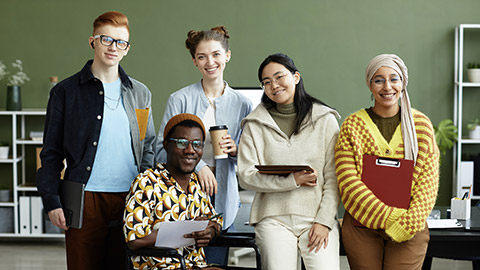A diverse and inclusive workplace has many benefits for everyone.
Diverse workplaces have team members from a range of different backgrounds and who may differ in terms of ability, age, gender, race and ethnicity. Inclusive workplaces are those where there is a widespread acceptance of the value of diversity and there are plans and actions put in place to promote and encourage diversity within the setting.
We know there are many benefits to having more diversity in a workplace, as well as plans and actions that ensure the workplace is inclusive.
Research across a range of countries and work types shows that diverse work teams often do better in a range of areas and there is also good evidence that inclusive workplaces are more effective and successful.
According to Frédéric Rozé, chief executive officer of L’Oréal USA, ‘Diversity fosters creativity. We need to generate the best ideas from our people in all levels of the company and incorporate them into our business practices.’ (Dickson, George, August 2019, 5 Reasons Diversity in the Workplace is a Competitive Advantage, https://blog.bonus.ly/5-competitive-benefits-of-diversity-in-the-workplace, accessed 16/12/19.)
Listening to the opinions of a wide range of people in a group or team is an effective way of bringing in new ways of thinking and problem solving. People who have different backgrounds and experiences can often think about situations in different ways. This can be a great way of helping the work team solve problems and come up with new ideas.
Activity
Watch the video Kadir’s Story then discuss his experiences as a Turkish person working for Services Australia.
Diversity and inclusiveness help people work more effectively with clients who use community services.
Diversity and inclusiveness in teams
Work teams often include people from many different backgrounds, age groups and abilities. A diverse work team is able to utilise the various skills and knowledge of each of the team members. This is a great way of providing services and supports to clients; the diversity of the work team means that individual needs can be met more easily.
Activity
Have a group discussion about the value of diversity in a community services work team. What benefits can you think of that are associated with diversity? What might happen if your whole work team was made up of people who had very similar backgrounds, experiences, ages and abilities?
Strategies that can work
There are several strategies which can support diversity and inclusiveness in work teams:
- Understanding discrimination and how it can affect clients and work activities
- Recognising that diversity is about differences between individuals rather than differences between groups
- Challenging negative thinking and stereotypes
- Focusing on strengths and skills rather than problems
- Encouraging team members to share their ideas and reflect on diversity and uniqueness
Managing challenges to diversity
In a community services workplace, it is helpful if the diversity of the work team relates to the diversity of the community in which it operates. This means valuing and respecting individual workers for the diversity they bring to the team. Each member of the work team is unique and important – they have a special set of skills, knowledge and experience that make them an individual. In the same way, the members of the broader community are also unique and individual. A work team which reflects the diversity of the community is able to understand, value and relate to community members who access their services. Many organisations need to manage the challenges of fair and equitable recruitment with meeting the needs of the community as a whole. Organisations which do not value diverse teams and team members are less able to provide services which are respectful of the diversity of their local community.
Activity
Visit the website Cultural Atlas. Choose a country which interests you and which is represented in your local community. Spend some time learning more about the culture – the people, language and traditions which are a part of that culture. Share your findings with a class mate and participate in a whole class discussion about the importance of learning about the cultures within your local community.Relationships are fundamental to success in many workplaces. Relationships are developed with:
Relationships based on mutual respect and understanding are more likely to be fruitful and productive. Relationships which are not based on respect and understanding are more likely to include negative and damaging aspects which can ultimately be harmful for the workplace as a whole and can lead to conflict, loss of productivity, and the potential for bias and discrimination to affect activities and outcomes.
Workplace relationships
Within a workplace, there are relationships that exist at many levels. The way these relationships are conducted depends to a certain extent upon:
- The relative seniority of the people involved
- The level of familiarity they have with each other
- The task to be performed
- The timeframe available
- Interpersonal and intrapersonal factors such as cultural awareness, confidence, assertiveness, communication style and knowledge of the task or activity
Workplace relationships often require people to work collaboratively to achieve business outcomes. Collaborative teams are able to use the shared and combined skills and knowledge of the whole team to solve problems, innovate, plan and create effectively. Collaborative teams are a great example of the saying ‘the whole is greater than the sum of the parts’ – that is, teams which are able to work together and utilise the best aspects of every team member are more likely to achieve success.
Collaborative teams which are comprised of people from diverse backgrounds are more likely to be able to succeed in innovation and creation type tasks. The research has found that including diversity aspects in a team results in higher levels of innovation and creativity than increasing the skills and knowledge of a less diverse team. In a recent study, data was analysed to see how well a multicultural team, comprised of members who did not share a common cultural background, were able to complete a creative business design task. The research found that having team members from diverse backgrounds had a positive effect on the creative solutions that were found to solve the problem.
…multiculturals can enable teams to capitalise on the strengths of cultural diversity to generate creative outcomes.Jang, Sujin (2017)
Professional relationships
Professional relationships are those which exist external to the workplace itself, such as with colleagues in a similar position in another agency, or with members of a training organisation or peak or advisory body. Professional relationships can be recognised because they include:
Cultural competence
Cultural competence is an area of skill development where there is a strong focus on learning about the skills and knowledge required to work effectively across teams and groups. Cultural competence training should be seen as an essential rather than a ‘nice to know’ aspect of doing business in Australia. As a strongly multicultural country, the ability to engage positively and to see great value in diverse teams is important.
Cultural competence must be role modelled and valued at the leadership level, as this is where the unspoken cultural code of the organisation is set. Many of the behaviours, ways of working and codes of acceptance are established by the leadership team, and then followed through the levels and layers of the workplace. If a leader demonstrates clearly that they embrace diversity and place great importance on building strong teams which can capitalise on the various skills and knowledge of their members, then this will follow through the workplace.
Building relationships with marginalised groups
Some groups of people in society are marginalised because of their previous experiences or because of particular characteristics that affect their ability to engage with activities and experiences in the community. Marginalised groups can experience difficulty in engaging with services. Building strong relationships with people who are marginalised can be an effective way of increasing the reach and achieving the outcomes of your agency or organisation.
Some people who have arrived in Australia as refugees, people who are experiencing homelessness, people who are affected by poverty or substance use, and those who are from an Aboriginal or Torres Strait Islander background may experience marginalisation, depending on the situation.
Relationship building should begin with an understanding of the needs and experiences of individuals and the knowledge that each person is unique. Avoid assumptions and stereotypes and instead base your thinking and actions on the specific needs of this person, at this time, with this activity.
Some people who have experienced trauma, discrimination, exclusion or negative attitudes may have been significantly affected by their experiences. This can cause them to display:
- A lack of trust in authority
- A belief that things will not change in the future
- A lack of hope and optimism
- Low self esteem
- Difficulty building new relationships
- Lack of understanding of Australian systems of support
- Limited ability to maintain social networks and friendships
- Heightened responses to criticism, negative experiences or other triggers
It can take time, effort and deliberate, planned approaches to build an effective and positive relationship with a person who has experienced trauma, discrimination, exclusion or negative attitudes in the past.
A workplace which is and feels safe for everyone is a fundamental human right., A safe workplace provides:
- Physical safety
- Social and emotional safety
- Mental health and wellbeing
- Appropriate responses to conflicts and disputes
- Access to fair and equitable processes, policies and systems of work
- Freedom to express individual needs and expectations
- Ability to be heard and responded to
- Absence of bullying, threats, coercion and intimidation
Some groups of people may find it more difficult to advocate for their own rights than others. Marginalised groups of people such as those who have multiple barriers toparticipation in community activities, have experience of mental illness, have a disability or are very young or old may find it more difficult to advocate for their own rights. They may, experience unsafe situations, or to be harmed by discrimination or bullying.
Cultural safety

Cultural safety is an important concept that relates to the notion of a safe workplace environment. According to Williams, cultural safety can be defined as:
Cultural safety means an environment that is spiritually, socially and emotionally safe, as well as physically safe for people; where there is no assault, challenge or denial of their identity, of who they are and what they need. It is about shared respect, shared meaning, shared knowledge and experience, of learning together with dignity and truly listening.
Williams, R (1999)
Cultural safety – what does it mean for our work practice?, Australian and New Zealand Journal of Public Health, 23(2), 213-214
One of the most effective strategies that can be used to build cultural safety is to focus on the culture and experiences of a person’s own background. This is in preference to focusing on the culture and experiences of another person, which can seem far easier to do but is in some ways less effective. By turning your attention inward, and thinking about how your own culture influences your decisions, actions and interactions, you are more able to help build a workplace which is culturally safe for everyone.
Work practices that contribute to safety
There are many ways of working that contribute to the development of a safe workplace environment. Helpful work practices can include:
Helpful and positive work practices do not occur in isolation. It is important that there is leadership acceptance for positive work practices and that cultural safety is valued and promoted across the workplace.
Activity
Reflecting on your own background, reflect on the types of influences in your own upbringing that have shaped you and what of these influences have you challenged?.
Now it's your turn
- Why is diversity important in the workplace?
- What are two (2) ways you can value diversity in the workplace?
- How could you challenge the negative perceptions on diveristy?

